The China-Malaysia Friendship Bridge has a total length of 2.1 kilometers and the main bridge is 760 meters long. It is located in the North Male Atoll of the Maldives, spanning the Gadu Strait and connecting Male Island and the Airport Island on the atoll. This bridge is the first bridge in this world-class tourist resort and the first sea-crossing bridge built on a coral reef in the world. After the bridge is completed, local residents and tourists no longer need to take a ferry between the two islands. The completion of the bridge will also greatly alleviate the traffic and housing pressures in the capital city of Male, and promote the development of logistics, tourism and new cities in the surrounding islands. Therefore, it is the most important island link project and major livelihood project in the Maldives.
Coral reefs are mainly distributed on the seabed in the sea where Maldives is located. In the underwater world, coral reefs enjoy the reputation of "tropical rainforest in the ocean" and "Great Wall at sea", but they bring great challenges to bridge construction. The bridge's nearly 200 piles and 27 pier foundations had to be built on coral reefs. Coral reefs are formed by biological calcification, the structure is loose and the texture is very brittle, the pile is a hollow, not only difficult to stand, but also suddenly sink. This is the first time in China that a bridge has been built on a coral reef. In order to ensure the stability of the bridge foundation and prevent seawater corrosion, the project department uses grouting technology to consolidate the side and bottom of the pile through grouting to improve the bearing capacity. First, a large hydraulic piling hammer is used to drive a hollow steel protective tube with a diameter of 3.6 meters and a length of more than 60 meters into the coral reef, and then concrete is poured into it to build a bridge foundation. The test pile is currently being driven. After verifying that the pile foundation can stand firm, the formal pile is driven. The longest pile is about 120 meters, and the deepest is more than 50 meters below the seabed.
Another major challenge faced by the project is that the sea conditions in the Indian Ocean are very harsh, and it is quite difficult to construct for 7 to 8 months a year. The wavelength of the sea wave reaches 200 meters, and it is difficult for general construction ships to stop, and the pile will sway continuously. To overcome this problem, the project department built a steel trestle and a water construction platform at sea.
There are a lot of corals on the sea floor, they are particularly sensitive to pollution, and the area where the bridge site is located is an important area for protecting marine biodiversity. For this reason, CCCC Second Aviation Bureau strictly abides by the environmental protection requirements, and the steel casing protects the construction operations from the external marine environment so that the construction mud will not be discharged. At the same time, strictly control the waste water and oil pollution generated by the construction ship and recycle it. The construction equipment also uses low-noise environmental protection materials to minimize the pollution to the marine environment.
Some steel pipe piles of this project are produced by Jiangsu Juxin Petroleum Steel Pipe Co., Ltd. The diameter of the steel pipe pile is 3600mm, and the thickness is 32mm and 50mm respectively. The 50mm thick pipe joints are distributed at the top of the pile at 1m and the pile bottom at 3m or 6m. The material is Q345C, the maximum length of the steel pipe pile is 120 meters, and it is produced by a three-roller forming and double-sided submerged arc welding process.
Except for the appearance quality of the welded steel pipe pile, all submerged arc welds are subject to 100% ultrasonic flaw detection (UT), and the acceptance standard is GB / T 11345-2013 "Ultrasonic detection technology, grade and evaluation of weld nondestructive testing" And Q ∕ CR 9211-2015 "Manufacturing Specification for Railway Steel Bridges". All ultrasonic inspections of welds must reach Class B inspection and pass Class Ⅰ. In addition to B-level inspection, C-level inspection is also required for some welds, specifically: 500mm at each end of the longitudinal butt welds and 500mm at the T-shaped cross-butt welds must be UT, C-level inspection, grade Ⅰ qualified; single welding For longitudinal and circumferential butt welds with a seam length greater than 1500mm, 10% of the total number of welds is extracted for UT, and the middle of the welded seam is 500mm for UT, C-level inspection, and Ⅰ-level qualification.
Due to the high quality requirements of this batch of steel pipe piles, in order to ensure product quality. The company's technical department first conducted a deposited metal test on the matching of welding materials to ensure that the strength of the welding materials met the design requirements. After the welding consumables are determined, the welding procedure qualification test of the base metal is conducted. Through the above tests, the welding materials and welding process parameters used in the production of steel pipe piles were determined. The technical department of the company is responsible for the preparation of technical documents such as WPS, inspection process card, anti-corrosion process card, etc., which are issued to the production, quality inspection and other departments after approval by the company's chief engineer.
At present, domestic bridge companies are moving from large rivers to oceans. In the future, there will be more and more sea-crossing bridges. The construction of bridges on coral reefs will provide examples for future bridge construction under similar marine environment and geological conditions.
|
